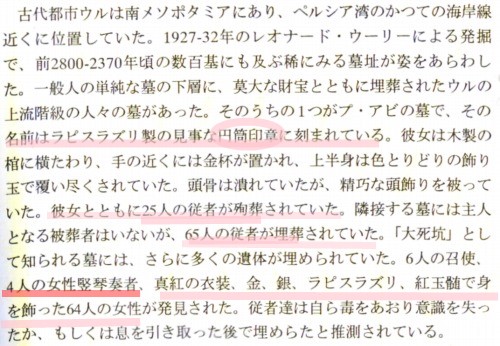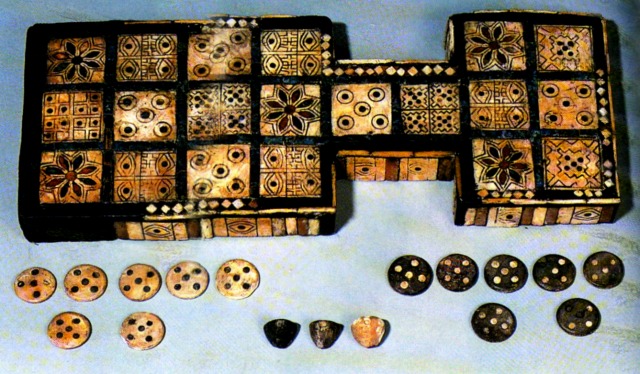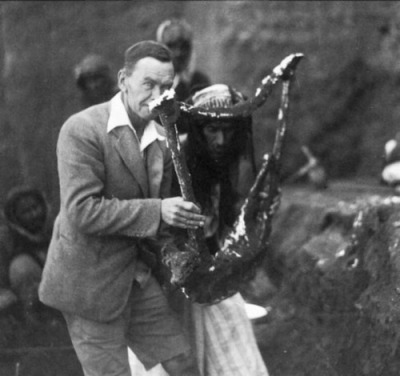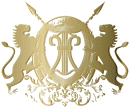古楽器:ウルのリラ
ウルの「スタンダード」

British Museum蔵 ラピス・ラズリ(※)、 コーンモザイク(※)
紀元前2600年から2400年頃の作(byWikipedia)、
2600 BC(英Wikipedia)
ウル「王墓」(※)出土、大英博物館蔵
「戦争のパネル」の面
発掘者のウーリー卿の考えとは違い、リラ(竪琴)の共鳴板だったのではないか、と。
(1929年に他のリラと共にウーリー卿が発掘。
※https://en.wikipedia.org/wiki/Lyres_of_Ur)
シュメールで都市文明が開花したウルク期には、コーン・モザイクと呼ばれる、円錐形の釘状の彩色土器や石(釘の頭の部分を彩色している)を使って神殿などの建築物が装飾されていた。ウルから出土した紀元前2600年から紀元前2400年頃に遡るとされる「ウルのスタンダード」は、持ち運びできるサイズの箱状の木材の各面に、貝殻や赤い石灰岩、青いラピスラズリを埋め込んだモザイクで、軍隊の行進や饗宴の場面が描かれている。(wikipedia)
戦争のパネル、平和のパネルという分け方(ウルのリラのモザイクは上記の「戦争のパネル」の裏右上にある)
https://en.wikipedia.org/wiki/Standard_of_Ur
The original function of the Standard of Ur is not conclusively understood. Woolley's suggestion that it represented a standard is now thought unlikely. It has also been speculated that it was the soundbox of a musical instrument.Paola Villani suggests that it was used as a chest to store funds for warfare or civil and religious works. It is, however, impossible to say for sure, as there is no inscription on the artifact to provide any background context.
ウーリー卿のサジェストした、戦争と平和でなく、シュメールの王の二重の役割、(※こちらのページ「棒と輪」論でもみた、) 王権の守護者としての王の役割を描いているのではないかという。
This would be a visual parallel with the literary device of merism , used by the Sumerians, in which the totality of a situation was described through the pairing of opposite concepts.
A Sumerian ruler was considered to have a dual role as a lugal (literally "big man" or war leader) and an en or civic/religious leader, responsible for mediating with the gods and maintaining the fecundity of the land.
※https://en.wikipedia.org/wiki/Lugal
ensiエンシ個々の都市国家の支配者、軍事指導者
→ウルの第3王朝以降、Lugalルガルl(字義は〈大きい人〉)はシュメール語で唯一の主権を指定するために使用されていた。
enエン 祭司・宗教的リーダー
(Thorkild Jacobsen(1904–1993)が理論化したとある・・・)
儀式の竪琴
『大英博物館のA to Z』p341
「やぶの雄羊」
山羊ですが、雄羊と呼ばれています(ルーム56)
山羊の形をしていますが、「やぶの雄羊」と呼ばれています。これを愛したレナード・ウリー卿が聖書の「イサクの犠牲」より命名したそうですよ。顔は金、角と体を覆う羊毛は貝殻とラピスラズリ、前足をかけている木はナツメヤシで出来ています。
「サソリ人間」
(ペンシルバニア大学蔵)
https://arthistory.about.com/library/weekly/bl_urrev.htm
Treasures from the Royal Tombs of Ur
A Special Exhibition Review by Stan Parchin
Ur's Third Dynasty (2600 to 2500 B.C.), at the height of Sumerian culture.
2650-2550 BC Gold, silver, lapis lazuli, shell, bitumen and wood (35.6 cm height of head, 33 cm height of plaque) University of Pennsylvania Museum of Archaeology and Anthropology Aside from Puabi's magnificent headdress, perhaps the most spectacular of Woolley's finds was the Great Lyre from the "King's Grave" at Ur.
https://arthistory.about.com/od/from_exhibitions/ig/RoyalTombsofUr/
Special Exhibition Image Gallery: The Royal Tombs of Ur
https://www.artnet.com/Magazine/news/walrobinson/
Golden goodies from ancient Sumarian Queen Puabi's tomb, excavated in the 1920s.
◎https://www.penn.museum/long-term-exhibits/iraq-s-ancient-past.html
https://www.britishmuseum.org/explore/highlights「Queen's Lyre」(大英博物館蔵)

これらの墓の被葬者は、当初は王や王妃であると推測されたが、メソポタミアでは類似の埋葬は存在せず、発見された称号もメソポタミアの王名リストには見当たらない。
ウルの月神の高官、特に女官であったのかもしれない。また聖婚の儀式の際に殺された神官、女官であったかもしれない
・・などなど
『大英博物館のA to Z』p341より引用

殉死

『大英博物館のA to Z』p341より引用
ウーリー卿発掘の この墓にあって、大英博物館収蔵となったのが、「林の牡山羊」(「やぶの雄羊」)(一対のもので家具の一部)、「ウルのスタンダ―ド」
Puabiの頭飾り、円筒印章、遺体はペンシルベニア大学博物館に展示
※ こちらのサイトでペンシルヴァニア大学所蔵のリラが見られます(大画像)https://www.lyre-of-ur.com/
The instrument shown here is one of the three original lyres of Ur found in 1929, which are held today in the Museums of Pennsylvania, London and Baghdad as unplayable models.
(大英博物館には、ここまでに挙げた、竪琴、金属容器のほかにゲーム盤などもあり) 下のものがウーリー卿発掘の紀元前2600年ごろの文物である。
墓で 「 いくつか発見された中で保存のよかったものがこれで、ロゼッタ文、眼、5つ星などが20の枠の中に配されている。2人が駒を競争して進めるゲームで、各人は7つの駒を持ち、三角錐や棒状のサイコロを使う。このタイプのゲームは紀元前3000年以前のシリアでも作られている。ウルに匹敵する時代の古いゲーム盤はイランで発見されており、またパキスタンにも古いものがある。」

![]() ゲームのやり方はこちらにあった・・
ゲームのやり方はこちらにあった・・
それはともかく、
唐草図鑑としては、この文物は別に見ているはずですが・・
「オリエントの文様」(小学館)には無かったようです・・ロゼッタ文
オリエントの文様図版を見る |
 オリエントとは オリエントとは |
| 麦と山羊 ウルクの大杯(ワルカの壺) ウルのリラ(ウルの「スタンダード」) シュメールのカウナケス | シュメールの神(エンリル、イエンナ) バビロンのヘビ(主神マルドゥクと聖獣ムシュフシュ) シムルグ |








